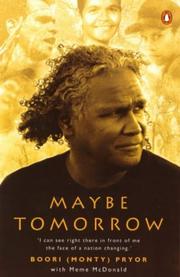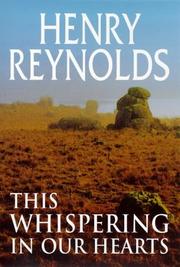| Listing 1 - 4 of 4 |
Sort by
|

ISBN: 0140273972 Year: 1998 Publisher: Victoria : Penguin Books,
Abstract | Keywords | Export | Availability | Bookmark
 Loading...
Loading...Choose an application
- Reference Manager
- EndNote
- RefWorks (Direct export to RefWorks)
Entertainers --- Aboriginal Australians --- Aborigènes d'Australie --- Biography. --- Pryor, Boori,
Book
ISBN: 186368235X Year: 1998 Publisher: Fremantle, W.A. : Fremantle Arts Centre Press,
Abstract | Keywords | Export | Availability | Bookmark
 Loading...
Loading...Choose an application
- Reference Manager
- EndNote
- RefWorks (Direct export to RefWorks)
Written specifically to maximise understanding of an extremely complex issue, this book examines the reasons why the policy of assimilation and the removal of Aboriginal children was introduced and maintained for so long. It reveals some of the long term effects of the policy and shows why the stolen generations are still a part. In 1937, the Australian government adopted an official policy of removing Aboriginal children from their families, a policy that envisaged the ultimate disappearance of the Aboriginal race. Although this policy was replaced after WWII with assimilation, much of the underlying purpose remained.
Aboriginal Australians --- Stolen generations (Australia) --- Prisonniers aborigènes d'Australie --- Aborigènes d'Australie --- Enfants --- Economics - Income - Poverty and low income. --- Race relations - Reconciliation. --- Race relations - Racism. --- Religions - Christianity - Church of Christ. --- Child welfare - Adoption and fostering. --- Government policy - Assimilation - 1926-1950. --- Child welfare - Children's homes. --- Socioeconomic conditions. --- Religions - Christianity - Missionaries. --- Religions - Christianity - Missions. --- Children - Abuse and neglect. --- Child welfare - Child / parent separation - Stolen generations. --- Government policy - Assimilation. --- Child welfare. --- Government policy. --- Social conditions. --- Politique publique. --- Conditions sociales. --- Protection, assistance, etc. --- Australia. --- Western Australia (WA)

ISBN: 1864485817 Year: 1998 Publisher: St. Leonards, New South Wales : ©1998 Allen & Unwin,
Abstract | Keywords | Export | Availability | Bookmark
 Loading...
Loading...Choose an application
- Reference Manager
- EndNote
- RefWorks (Direct export to RefWorks)
A different history of Australia through the eyes of largely forgotten people. The book begins with Australia's first punitive expedition in 1790 and ends on the eve of World War II with Harry Bennett expressing anger about the condition of the Aboriginies and the attitudes of white Australia.
Race discrimination --- Aboriginal Australians --- Aboriginal Australians, Treatment of --- Humanitarianism. --- Relations interethniques --- Discrimination raciale --- Aborigènes d'Australie. --- Aborigènes d'Australie --- Humanitarisme. --- Race relations - Attitudes. --- Settlement and contacts - Colonisation - 1788-1850. --- Settlement and contacts - Colonisation - 1851 --- -Race relations - Violent. --- Race relations - Violent - Massacres, murders, poisonings etc. - 1901 --- -Race relations - Violent - Massacres, murders, poisonings etc. - To 1900. --- First contact with Europeans. --- History. --- Premiers contacts avec les Occidentaux --- Histoire --- Australia --- Forrest River (WA East Kimberley SD52-09, SD52-10, SD52-14) --- Caledon Bay (East Arnhem Land SD53-04) --- Queensland (Qld) --- Western Australia (WA) --- New South Wales (NSW) --- Yurrkarrn / Coniston (South Central NT SF53-09) --- Race relations.
Book
ISBN: 0091837278 Year: 1998 Publisher: Milsons Point, New South Wales : Random House,
Abstract | Keywords | Export | Availability | Bookmark
 Loading...
Loading...Choose an application
- Reference Manager
- EndNote
- RefWorks (Direct export to RefWorks)
Aboriginal Australians --- Motion picture actors and actresses --- Aborigènes d'Australie. --- Social behaviour - Roles. --- History - Biographies - Non-Indigenous - Autobiographies. --- History - Biographies - Indigenous. --- Performing arts - Actors. --- Occupations - Domestic servants. --- Race relations - Racism. --- Occupations - Pastoral industry workers. --- History - Genealogy and family history. --- Wajarri / Watjarri people (A39) (WA SG50-7, SG50-11) --- Social life and customs. --- Dingo, Sally, --- Dingo, Ernie. --- Geraldton map area (SW WA SH50-01) --- Mullewa (SW WA SH50-02) --- Byro map area (WA Gascoyne / Murchison SG50-10)
| Listing 1 - 4 of 4 |
Sort by
|

 Search
Search Feedback
Feedback About UniCat
About UniCat  Help
Help News
News